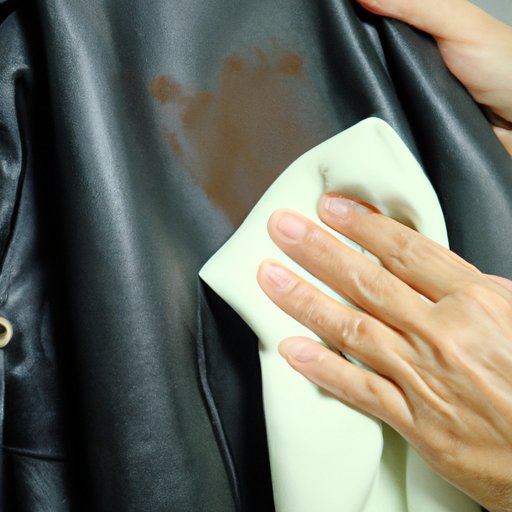
Introduction
A leather jacket is one of the most stylish and timeless fashion pieces that can last for years if maintained properly. However, cleaning a leather jacket can be tricky as it requires special care and attention. In this article, we will guide you through the step-by-step process of cleaning your leather jacket and provide tips, tricks, and expert advice to keep it looking new.
Understanding Your Leather Jacket
Before diving into the cleaning process, it’s important to understand your leather jacket’s unique characteristics. Not all leather jackets are made of the same type of leather, and each requires different cleaning techniques. Some common types of leather include cowhide, lambskin, sheepskin, and suede.
It’s essential to identify the type of leather your jacket is made of before deciding on a cleaning method. Different leathers have different cleaning requirements, and using the wrong cleaning technique can damage the leather or, worse, ruin your jacket.
Pre-Cleaning Preparation
Before cleaning your jacket, it’s essential to prepare it. This step involves removing dirt and debris from the jacket’s surface. Start by using a soft-bristled brush or a dry cloth to gently wipe off any dirt or dust from the jacket.
Next, look for any visible stains or marks on the jacket’s surface and remove them gently. Avoid using harsh chemicals or abrasive materials, as they can leave marks on the leather.
It’s also important to check the jacket for any loose stitching or seams and repair them before cleaning the jacket.
Step-by-Step Cleaning Instructions
Once you’ve prepared your leather jacket, it’s time to clean it. The first step is to find a mild leather cleaner that’s suitable for your type of leather. Avoid using household cleaners or detergents, as they can damage the leather.
Test the cleaner on a hidden area of your jacket before using it to ensure that it won’t cause any discoloration or damage to the leather. Then, apply a small amount of the cleaner to a soft cloth and gently rub it onto the jacket’s surface.
Avoid applying too much pressure while cleaning the jacket. Using too much force can damage the leather and lead to discoloration.
Once you’ve cleaned the jacket, wipe it with a clean, damp cloth to remove the cleaner residue. Then, use a dry towel to gently pat the jacket to remove any excess moisture. Leave the jacket to air dry away from direct sunlight and heat sources.
Removing Stains and Smells
Leather jackets can encounter different types of stains and smells that need specific cleaning approaches. Some common stains include oil, ink, and watermarks. For oil and ink stains, use a leather degreaser to dissolve the oil or ink without damaging the leather.
For watermarks or mildew smells, mix equal parts water and vinegar and apply the solution to the stains or smells with a soft cloth. After cleaning, wipe off the solution with a damp cloth and leave the jacket to air dry.
To prevent future stains and smells, apply a leather protectant regularly to your jacket. The protectant helps to seal moisture out, keeping stains and smells from penetrating the leather surface.
Expert Advice for Leather Jacket Care
According to leather care professionals, it’s essential to condition and protect your leather jacket regularly. Use a leather conditioner to keep your jacket supple and prevent it from drying out and cracking.
When storing your leather jacket, hang it on a sturdy hanger in a well-ventilated area away from direct sunlight and heat sources. Avoid storing your jacket in plastic bags, as they can trap moisture and cause your jacket to rot.
DIY Leather Jacket Cleaning Techniques
Several DIY leather cleaning techniques can come in handy when you don’t have access to professional leather cleaners.
For instance, you can use milk to remove ink stains from your leather jacket. Dampen a cotton pad with milk and gently rub it onto the stain until it fades away.
You can also use a mixture of baking soda and cornstarch to remove oil and grease stains from your jacket. Apply the mixture to the stain and let it sit for several hours before brushing off the powder gently.
However, while DIY techniques can be convenient, they have drawbacks compared to professional cleaning. For instance, DIY techniques may not remove all the stains, causing them to set in and damage the jacket’s leather.
Conclusion
Cleaning a leather jacket can seem daunting, but with the right techniques and tools, it can be easy and straightforward. Remember to identify the type of leather your jacket is made of, prepare it before cleaning, and follow the recommended cleaning techniques.
Expert advice and DIY techniques can also be handy in keeping your jacket looking new. By taking care of your leather jacket, you’re not only keeping it in pristine condition, but also extending its lifespan.





